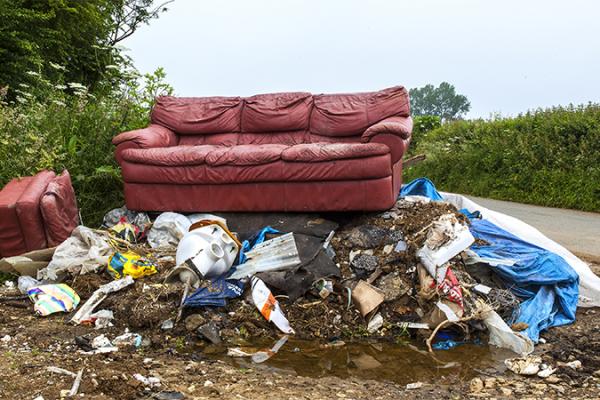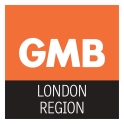GMB London call on councils to be more active against fly-tipping

GMB London call on councils to be more active against fly-tipping with 75,447 incidents in East of England in year to end March 2017
All councils must be more active to investigate and punish the anti-social behaviour of fly-tippers as nothing less than a policy of zero tolerance should be acceptable says GMB LondonIn the year to end of March 2017 46 local authorities in the East of England had to clear 75,447 incidents of fly-tipping. During the same period these councils took 51,201 separate actions to investigate and deal with fly-tippers.
There was a huge variation both in the number of incidents of fly tipping and the level of activity by councils in trying to find the perpetrators and punish them.
Colchester reported no actions taken in 2016-17 against fly-tipping.
The next lowest ratio of local authority actions to fly-tipping incidents was Breckland with 0.02 followed by East Hertfordshire with 0.05, South Norfolk with 0.13, Great Yarmouth with 0.17 and Brentwood with 0.22.
Southend-on-Sea was the most active local authority in the East of England with 7.5 actions to incidents followed by Forest Health with 2.88, St Edmundsbury with 2.6, North Norfolk with 2.58 and East Cambridgeshire with 1.79.
The local authority with the highest number of fly tipping incidents in 2016-17 was Peterborough with 8,186, over 10% of the East of England total. Next highest is Great Yarmouth with 7,993 (also over 10% of East of England total) fly-tipping incidents followed by Basildon, with 5,762, Norwich with 5,264, Luton with 4,946 and Stevenage with 4,287.
The local authority with the lowest amount of fly-tipping incidents was Uttlesford with 193 followed by South Cambridgeshire with 211, East Cambridgeshire with 214, Suffolk Coastal with 223 and Forest Heath with 264.
In England there were 1,002,154 incidents of fly-tipping with 474,460 actions taken by local authorities.
Councils now have extensive powers to take action against fly tipping. There can be more than one action per incident and an action takes the form of one or more of the following: Investigation, warning letter, statutory notice, fixed penalty notice, duty of care inspection, stop and search, vehicle seized, formal caution, prosecution or an injunction [see notes to editors for definitions].
Set out in the table below are the 2016-2017 figures for 46 Local Authorities in the East of England region ranked by lowest ratio of Local Authority actions to number of fly-tipping incidents.
The tables have been compiled by GMB London region, see notes to editors for sources and definitions.
|
Fly-tipping incidents and actions reported by local authorities 2016-17 |
||||
|
Total number of fly tipping incidents |
Total Actions reported by Local Authorities |
ratio of actions to incidents |
||
|
England |
1,002,154 |
474,460 |
0.47 |
|
|
East |
75,447 |
51,201 |
0.68 |
|
|
rank |
||||
|
1 |
Colchester |
1,591 |
0 |
0.00 |
|
2 |
Breckland |
1,060 |
20 |
0.02 |
|
3 |
East Hertfordshire |
1,114 |
58 |
0.05 |
|
4 |
South Norfolk |
680 |
86 |
0.13 |
|
5 |
Great Yarmouth |
7,993 |
1,331 |
0.17 |
|
6 |
Brentwood |
558 |
123 |
0.22 |
|
7 |
Huntingdonshire |
692 |
157 |
0.23 |
|
8 |
Norwich |
5,264 |
1,239 |
0.24 |
|
9 |
Mid Suffolk |
324 |
80 |
0.25 |
|
10 |
Watford |
1,414 |
378 |
0.27 |
|
11 |
Welwyn Hatfield |
2,664 |
753 |
0.28 |
|
12 |
Chelmsford |
503 |
144 |
0.29 |
|
13 |
Luton |
4,946 |
1,601 |
0.32 |
|
14 |
King's Lynn and West Norfolk |
1,980 |
765 |
0.39 |
|
15 |
St Albans |
1,324 |
517 |
0.39 |
|
16 |
Stevenage |
4,287 |
1,843 |
0.43 |
|
17 |
Epping Forest |
2,384 |
1,064 |
0.45 |
|
18 |
Babergh |
289 |
139 |
0.48 |
|
19 |
Fenland |
1,428 |
713 |
0.50 |
|
20 |
Harlow |
2,614 |
1,306 |
0.50 |
|
21 |
Peterborough |
8,186 |
4,262 |
0.52 |
|
22 |
Hertsmere |
800 |
435 |
0.54 |
|
23 |
Uttlesford |
193 |
109 |
0.56 |
|
24 |
Maldon |
309 |
188 |
0.61 |
|
25 |
Ipswich |
579 |
368 |
0.64 |
|
26 |
Central Bedfordshire |
1,153 |
875 |
0.76 |
|
27 |
Waveney |
871 |
792 |
0.91 |
|
28 |
Castle Point |
910 |
910 |
1.00 |
|
29 |
Basildon |
5,762 |
5,769 |
1.00 |
|
30 |
Rochford |
688 |
690 |
1.00 |
|
31 |
South Cambridgeshire |
211 |
215 |
1.02 |
|
32 |
Tendring |
1,132 |
1,177 |
1.04 |
|
33 |
North Hertfordshire |
925 |
966 |
1.04 |
|
34 |
Broadland |
436 |
474 |
1.09 |
|
35 |
Three Rivers |
714 |
783 |
1.10 |
|
36 |
Bedford |
2,906 |
3,369 |
1.16 |
|
37 |
Cambridge |
1,889 |
2,388 |
1.26 |
|
38 |
Braintree |
724 |
940 |
1.30 |
|
39 |
Broxbourne |
754 |
1,123 |
1.49 |
|
40 |
Dacorum |
1,261 |
1,905 |
1.51 |
|
41 |
Suffolk Coastal |
223 |
346 |
1.55 |
|
42 |
East Cambridgeshire |
214 |
383 |
1.79 |
|
43 |
North Norfolk |
495 |
1,279 |
2.58 |
|
44 |
St Edmundsbury |
334 |
868 |
2.60 |
|
45 |
Forest Heath |
264 |
759 |
2.88 |
|
46 |
Southend-on-Sea |
405 |
3,039 |
7.50 |
|
Thurrock |
: |
4,472 |
: |
|
|
Thurrock submitted incomplete data for quarters one and two, and had unresolved data queries for quarters three and four, so an estimate was made by Defra for the full year. Total incidents were provided but the return was missing breakdowns by land type, waste type, a size, so estimates were made based on the proportions from 2015/16. |
||||
Warren Kenny, GMB London regional secretary, said,
“Fly tipping is deeply anti social behaviour and can never be tolerated.
“Councils have to develop and implement a culture of zero tolerance so that those who fly tip understand that the chances of being identified and punished are very high.
“Councils need to learn from each other and as well as having investigation and enforcement teams they need to mobilise the full hearted support of the local community for the policy of zero tolerance.
“Given the prevalence of mobile smartphones, authorities should make it easy for members of the public to send them pictures of anti-social fly-tipping incidents as they happen in the full and certain knowledge that these incidents will be followed up.
“These latest figures show that some councils are not as proactive as they should be in dealing with fly-tipping. GMB is calling on all councils to be more active to investigate and punish the anti social behaviour of fly-tippers. Nothing less than a policy of zero tolerance should be acceptable.”
ENDS
Contact: Tony Warr 07710 631336; Dave Powell 07710 631349; Keith Williams 07710 631339
Notes to editors:
1) Source: Department for Environment, Food & Rural Affairs Waste and Recycling statistics. Fly tipping incidents and actions taken reported by local authorities in England, 2017.
www.gov.uk/government/statistical-data-sets/env24-fly-tipping-incidents-and-actions-taken-in-england
2) Fly-tipping is the illegal deposit of waste on land. These fly-tipping incidents are those reported to local authorities and do not include the majority of incidents on private land.
3) Actions taken by councils
Investigation
The enforcement team has recorded the incident, identified the evidence available and has either decided the action to be taken or is considering this. If a decision has been made the incident could also have generated other actions in the list. The cost of this has been calculated using national average costs.
Warning letter
A warning letter has been sent or handed to the perpetrators or the land occupiers/owners. The cost of this has been calculated using national average costs.
Statutory notice
A statutory notice related to fly-tipping has been served on the perpetrators or land occupiers/owners. This would include s59 and s71 of the EPA. It may also include community protection notices where the intention is also to control fly-tipping. The cost of this has been calculated using national average costs.
Fixed penalty notice
In May 2016 local authorities were given the power to issue fixed penalty notices of up to £400 for small scale fly-tipping as an alternative to more costly prosecutions in England.
A fixed penalty notice has been served on the perpetrators in connection with a waste offence regardless of whether it has been paid. (See under prosecution outcomes to record number paid). This refers to use of s88 of the EPA (but only when used against small scale fly-tipping), s34A of the EPA (failure to furnish documentation), s47ZA of the EPA (offences relating to waste receptacles) and s5B and s5C of COP(A)A 1989 (failure to produce authority). Further information on the number of all FPNs issued and paid will be required but will be collected annually. The cost of this has been calculated using national average costs.
Duty of care inspection
A business has been asked to provide waste transfer notes or a household is investigated for possible breaches of their duty. Note this may also result in one of the actions listed in the rows above; if so include in both. Count each business or household inspected. The cost of this has been calculated using national average costs.
Stop and search
A stop operation has been held in conjunction with the Police and waste carriers asked to produce evidence that they are registered waste carriers. It may also include other agencies/other checks. The cost of this has been calculated using national average costs. It is assumed that each operation will last roughly 2 hours maximum. If the operation continues for circa another two hours in the afternoon, count this item twice.
Vehicles seized
Where a vehicle has been seized as it is believed to have been involved in fly-tipping. If more than one vehicle has been seized please enter the total number of vehicles seized.
Formal caution
A formal caution has been issued. If a number of offences relate to one incident, count each formal caution for each offence. The cost of this has been calculated using national average costs.
Prosecution
Each prosecution case taken to court regardless of the outcome. If several prosecutions are taken against a perpetrator/suspect even if this relates to just one incident, you should include all the prosecutions. E.g. if prosecuting two suspects each under section 33 and 34 of the EPA count this as four prosecutions. You will need to estimate and total your own costs of preparing the case(s) and taking them to court but exclude costs that have been recorded elsewhere (e.g. costs of surveillance).
Injunction
A magistrate’s court has issued an injunction to an individual or business who has failed to take the action required by a statutory notice.


